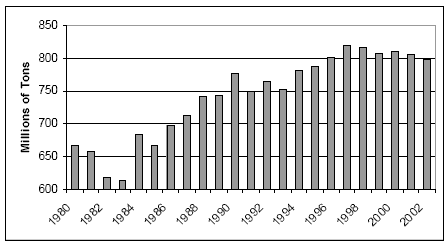|
History of Commerce on the Mississippi River
It is speculated that the Mississippi water ways and basin were used for transportation as early as 11000 years ago. Since that time the Mississippi has remained a vital artery of commerce for everything from the Appalachian Mountains to the east and the Rocky Mountains to the West. In 1705 the first cargo was hauled on the Wabash River south to Bayou Manchac on the Mississippi River.
By 1820 the government began to consider how to tame the Inland Waterways, causing transportation on the rivers to expand at a great pace.
Their earliest efforts were in the 1860's when the Army Corps of Engineers received $4 million dollars to remove some troubling rapids at the mouth of the Des Moines and Rock Rivers.
Throughout the 19th century thousands of small structures, such as wing dams and closing dams, were built in an effort to allow the river to do the work of cutting and maintaining the shipping channels by itself. The method worked well until the channel from Minneapolis south was increased in depth from 4 feet to 6 feet to allow larger commercial vessels to travel on the upper Mississippi River system, requiring larger lock facilities.
With commercial interest growing in the Midwest, increasing pressure was placed on the government to create deeper and more stable channels in the river. In the 1930's, after much deliberation in Congress and objections from the President, plans were made to build a system of locks and dams to raise the water level north of St. Louis to 9 feet. Taking advantage of nearly $164 million of Franklin D. Roosevelt's New Deal money, the current lock and dam system of the upper Mississippi river was completed during the 1940's. The following shows a picture of a barge fleet passing through a dam on the Tennessee River after having traveled down the upper Mississippi and the Ohio rivers.
Traffic on the river didn't boom until after World War II when trade with foreign nations increased the need for the faster transport of raw materials.
In fact, the Mississippi, as we know it today, is little more than modifications and improvements of the existing framework set by the Corps of Engineers during the early 20th century. Cargo has been steadily rising on the river system, and has averaged 806 million tons each year.
 Image used with permission AWO Image used with permission AWO
American Waterways Association
http://www.americanwaterways.com/barge_traffic.htm
http://www.americanwaterways.com/Tons_moved.pdf
Center for Global Environmental Education
http://cgee.hamline.edu/rivers/Resources/Voices/transportation1.htm
New Orleans District, U.S. Army Corps of Engineers on the Mississippi River
http://www.mvn.usace.army.mil/pao/history/MISSRNAV/river.asp
http://www.mvn.usace.army.mil/pao/history/MISSRNAV/commerce.asp
http://www.mvn.usace.army.mil/pao/history/MISSRNAV/navigation.asp
Tenessee Valley Authority
http://www.tva.gov/river/navigation/economic.htm
|

